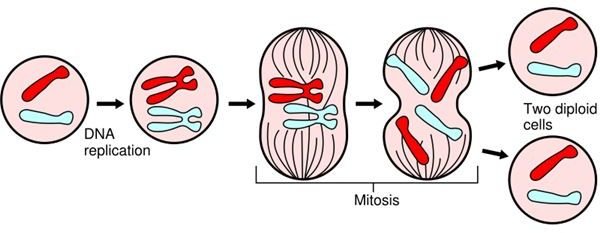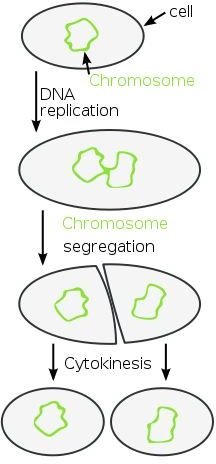What Happens During Cytokinesis: Prokaryotes and Eukaryotes
Backdrop of Cell Division
All cells have a process of division in order to reproduce. For example, certain prokaryotes reproduce using binary fission while eukaryotes reproduce through mitosis or meiosis. In this regard, cytokinesis is important for both animal and plant cells in that it allows the cell to divide at the end of either process. Usually linked to telophase, cytokinesis is the last step that allows a cell to divide into two daughter cells and continue its reproductive process.
Cytokinesis in Prokaryotes
What happens during cytokinesis for prokaryotes? Like eukaryotes, cytokinesis is the last stage of separation for prokaryotes in a process called binary fission. It is important to remember that prokaryotes do not use mitosis or meiosis that certain animal and plant cells use in division.
During binary fission, a prokaryote begins by replicating its nucleiod (DNA) in the cell. Once this happens, the two nucleiods travel to the ends of the cell where there is cytokinesis. It is here where cytokinesis finishes the process of dividing the two nucleiods by allowing each to construct their own cell walls and cell membranes. Once the two nucleiods finish their cell walls, they split from each other producing a parent copy as well as a daughter copy.
Cytokinesis in Eukaryotes
What happens during cytokinesis in eukaryotes is much more complex and time consuming than prokaryotes. We will be focusing on how animals and plants use the process of mitosis in order to divide. Remember that animal cells can also use meiosis when dividing gamete cells such as the ova or sperm cells; however, we are simply referring to somatic (bodily) cells in this article.

The goal of mitosis is to duplicate chromosomes (genes) in order to divide and pass on the information in a new cell. Roughly there are five stages: interphase, prophase, metaphase, anaphase and lastly telophase. Interphase is a resting step that is not concerned in dividing; however, it allows the cell to develop until it is ready for reproduction.
In prophase, the process begins in which the chromatids (future chromosomes) start to dissolve and break away to become chromosomes. Next is metaphase, in which the chromatid turned chromosomes line up along the middle of the cell called the metaphase plate. In anaphase, the chromosomes are pulled to the ends of the cell in order to begin the process of telophase.
The last step is called telophase, which allows the daughter and parent cells to break off from one another. It is in this step that cytokinesis takes place. Animal cells use cytokinesis to form a cleavage furrow along the center of the cell which allows the new daughter cell to “pinch off” from the parent cell. Plant cells use a different approach in that they form cell walls along the metaphase plate. Once these cell walls form, the two cells split from each other and complete the reproductive process.
References
Sources:
- Carter, J. Stein. “Mitosis.” https://biology.clc.uc.edu/courses/bio104/mitosis.htm
- Korgh, David. “Information to Genetics: Mitosis and Cytokinesis.” https://wps.prenhall.com/esm_krogh_biology_3/17/4437/1135980.cw/index.html
Images:
- JWSchmidt. “Binary Fission.” https://en.wikipedia.org/wiki/File:Binary_fission.svg
- Mysid. “Major Events in Mitosis.” https://en.wikipedia.org/wiki/File:Major_events_in_mitosis.svg
This post is part of the series: All About Cytokinesis
Need to know all about cytokinesis? Learn about the the process of cytokinesis as well as how it works in animal and plant cells.
